Marvel’s 1992 WCW: World Championship Wrestling comic was a star-studded affair that featured some of the greatest names in grappling history. But even Sting, The Steiners, Cactus Jack, and Vader couldn’t save the WCW comic from fizzling out after only a dozen issues. We dig into the fascinating and lesser-known tale behind why it failed.
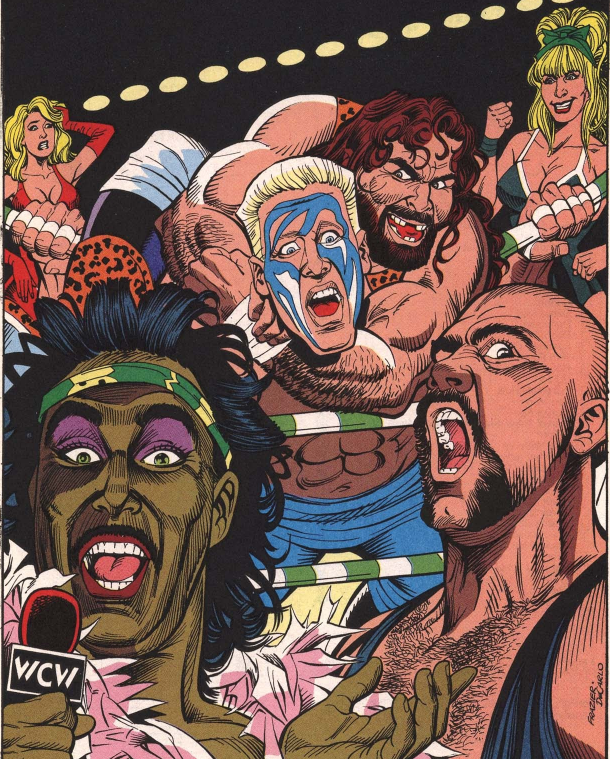
A Brief Look at Wrestling Graphic Novels and Marvel’s Failed WCW Comic Book
Neither the WWE nor WCW was the first to feature wrestlers in comic book form.
As far back as 1905, we see an illustrated George Hackenschmidt with dialogue dominating his opponents. And thanks to the souvenir program from April 3, 1908, we are transported to the first match between Frank Gotch and the “Russian Lion” George Hackenschmidt at Dexter Park Amphitheatre.
Their almost mythical rematch occurred on September 4th, 1911, and is often called “The Original Screwjob.” You can read all about it here.

Although not a comic book, in 1937, Porky the Pig in “Porky the Wrestler” became the first Loony Toon and cartoon to step into the squared circle, years before the more widely known Bugs Bunny vs. The Crusher in “Bunny Hugged” in 1951.
In June 1942, Wonder Woman appeared, along with a minor character named Fatsis, who might be the first wrestling comic book character.
In 1948 Smash Comics introduced a “sensational new laugh character: Daffy the Female Wrestler.”
The red-headed champion hog-caller Daffy Dill came from Kookasow, Iowa, where she met Deke “Oxford” Parsons, who guided her through women’s wrestling. Their relationship mirrors the relationship between real women’s wrestler Mildred Burke and her spouse, the duplicitous Billy Wolfe.

The widely popular Dick Tracy entered the wrestling game in 1950 and introduced the villain TV Wiggles. This wavy-haired fidgety former professional wrestler turned to a life of crime.
Well into his wrestling career, but six years before his movie, Mexican luchador and pop cultural icon El Santo starred in his comic book in 1952. It consisted of actual photos combined with artwork and illustrated backgrounds, all in sepia, giving the popular publication more of a scrapbook appearance.
Other luchadors of the time, like Blue Demon, Black Shadow, Huracán Ramirez, and later Mil Máscaras, also got their comics.

With their unique style, Japan dipped its toes into the wrestling comic book pool with Tiger Mask, whose original run from 1968 to 1971 consisted of 14 volumes.
The early ’80s saw New Japan Pro Wrestling (NJPW) license the character, and Satoru Sayama portrayed the original incarnation of the manga superhero and Mitsuharu Misawa the second.

Minor wrestling characters appeared in American comics during the ’70s and ’80s. More well-known ones include The Thing (Ben Grimm), Ms. Marvel (Sharon Ventura), Marvel Boy (Justice), and X the Marvel (Willie Dance).

The Battle For Merchandising Supremacy
During the last years of the wrestling territories, Turner Broadcasting System bought the assets of Jim Crockett Promotions (JCP) of the NWA in 1988. It then rebranded as World Championship Wrestling (WCW) and positioned itself to offset the then-WWF’s dominance in the market.
An often-told story recounts an elated Ted Turner calling Vince McMahon up in his southern drawl and proudly declaring that he was now “in the rasslin’ business,” with McMahon shooting back, “Well, that’s great Ted, but I’m in the entertainment business!”
During this time, the now-rebranded World Championship Wrestling was already a successful wrestling company. But in terms of national popularity through television exposure and revenue streams like consumer products and specifically merchandising, WCW for years played catch-up behind Vince McMahon’s Titan Sports.

Pre-1985, the WWF sold merchandise at its shows and through WWF Magazine. But from 1985 onward, they released a yearly catalog chock-full of goods where anything with its now classic WWF logo and superstars became an increasingly important revenue stream behind pay-per-views and ticket sales.
In 1989, WCW, still playing catch up, followed suit and released a yearly merchandise catalog nearly identical in products to the WWF’s.
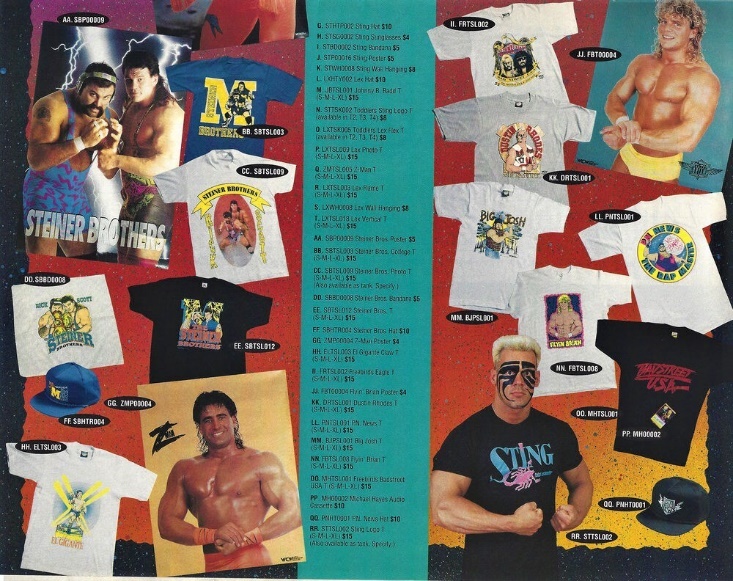
But the WWF beat WCW to the punch in the comics industry too. In early 1991, they released four “Illustrated Action Books” published by Valiant. And from August 1991 through March 1992, Valiant also published “WWF Battlemania” comic books.
The WCW Comic
To continue chipping away at the WWF’s pop cultural stranglehold, WCW collaborated with Marvel and released WCW: World Championship Wrestling in early 1992. It featured the WCW stars in and out of the ring. The first “Body-Slamming Collector’s Issue” of WCW’s comic had Lex Luger gracing the cover.
From April 1992 through March 1993, it ran for 12 issues. Mike Lackey wrote it with Ron Wilson serving as penciler. The inker, letterer, colorist, and editors varied.
In a comic series, this is not unusual but something to note when analyzing what may have limited the WCW comic from continuing.

A comic book or graphic novel can have as few or as many people onboard as needed, but most of the time, it’s not a solo endeavor. It is like an assembly line with specialized tasks and a looming deadline. For example, in a series, while issue #1 is hitting newsstands, someone could be finishing up on the penciling, inking, and then coloring issue #2.
In the last issues of the WCW comic, the people involved were only named without noting the specified tasks; they sometimes even humorously used nicknames, as seen in wrestling. Were these later issues more rushed than the usual Marvel-produced comic series? There’s a slight difference in quality between the early and last issues, so the jury is out on that.
Writer Mike Lackey’s notable works include various Spider-Man, Fantastic Four titles, and The Punisher. But when searching for all his work at marvel.com, curiously, WCW is nowhere to be found, erased from history. The same goes for Ron Wilson, who’s been in the industry since the early ’70s and has an enviable portfolio rivaled by few.
So why the WCW snub? Is it because it was licensed and not a Marvel property?
“He’ll do whatever it takes to keep his championship. If a few necks get BROKEN, he won’t lose any sleep. On the contrary, he’d probably laugh.”
–Issue #1 of the WCW comic introducing Lex Luger.
Why Did the WCW Comic Fail?
While the Modern Era of comics (1985-Present) involves more twisting plots, complex characters, and anti-heroes, this is where the WCW comic perhaps failed to deliver.
The WCW comic seemingly wanted to be “all things to all people.” How could it cater to a hardcore fan base of all ages, casual wrestling viewers, and avid comic book readers? It was an overly ambitious undertaking.
And if the creators of the WCW comic were banking on readers of traditional comic book superheroes to view pro wrestlers the same as fantasy characters, they were wrong. Although wrestlers perform spectacular athletic feats, they are not superhuman. As a result, wrestling won’t necessarily interest your usual comic book fans.
For instance, a mystery man hires Cactus Jack and “The Pistols” tag team of Tracy Smothers and Steve Armstrong to “take out” Sting by blowing up a bomb on the “Bruise Cruise” he’s on with a bunch of fans.
There was the potential for drama here, but the premise is like an ’80s episode of the A-Team. You might have seen this in El Santo’s adventures, but it was too farfetched even for a kayfabe wrestling storyline, or even for fans who read the “Apter Mags,” and way too goofy for a comic book.

Another observation is that the wrestling action doesn’t translate well in a panel-to-panel format. Plus, their renderings often left much to be desired. As a result, you’re sometimes hard-pressed to recognize the wrestlers or cringe at frightening renditions of them like a grotesque Johnny B. Badd!

While there are witty remarks and one-liners thrown by Paul E. Dangerously, Jesse Ventura, Missy Hyatt, and some wrestlers, the banter between them and the bombardment of puns felt forced.
Also, the artists demonstrate more often than not that they probably barely watched wrestling.
Wrestlers use superkicks repeatedly to eliminate people in the premier issue’s battle royal. Wrestlers also land straight on their heads when taking a piledriver. Were these liberties taken by the artists or a demonstration of their wrestling ignorance?
Some of the storylines tried to follow what WCW was doing at the time. But that quickly got thrown out the window by Issue #3 after Lex Luger jumped ship to the WWF.
Sting became the main babyface, and the issues got progressively stranger. WCW force-fed Johnny B. Badd; Sting was hypnotized and became the malevolent Black Stinger.
Or how about the mysterious appearance of The Ghoul, who terrorized WCW? He looks like a monster out of a cheesy low-budget grindhouse movie. How dense did the creators think wrestling or comic book fans were?

The Positives
But with all that said, the WCW comic has its fun moments.
Seeing some of your favorite wrestlers as comic book characters is a nostalgic kayfabe treat.
Scoping out the off-beat ads for Super Nintendo games, sports cards, and assorted ’90s candies is worth your time alone. Also, ads for upcoming comics take you down memory lane, and Stan Lee’s editorial column was often entertaining. You could’ve done much worse at $1.25 an issue in 1992 money.
Perhaps, there were never plans to go further than twelve issues, but its finale seems to have been left open-ended for later stories.
Interestingly, despite their failure, in 2000, WCW took a stab once more at the comic book market. Marvel released S.L.A.M. FORCE, which stands for “Secret Legion Against Monsters.” It was mainly to promote and sell a toy line.
Released as a mini-comic that came packaged with each action figure, Issue #1 pitted WCW’s wrestlers (Sting, Goldberg, Chris Benoit, Kevin Nash, and Bret Hart) as a covert strike force wearing cool armor and sporting weapons who hunt supernatural creatures ala Van Helsing.
Inside, an impassioned Goldberg urges the reader to subscribe to obtain the other upcoming 11 issues, which perhaps were never published. If you know more about this, please drop us a line!
Best Moments from the WCW Comic Not To Be Missed
Sit back and relax and let’s go back and check out some more fun panels of the original WCW comic:

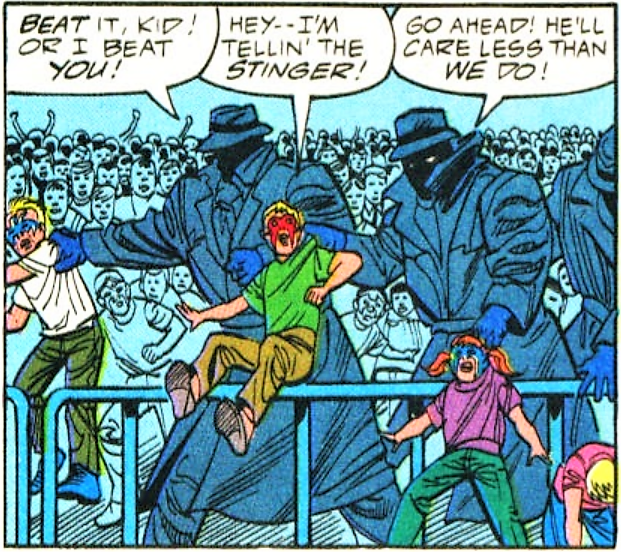








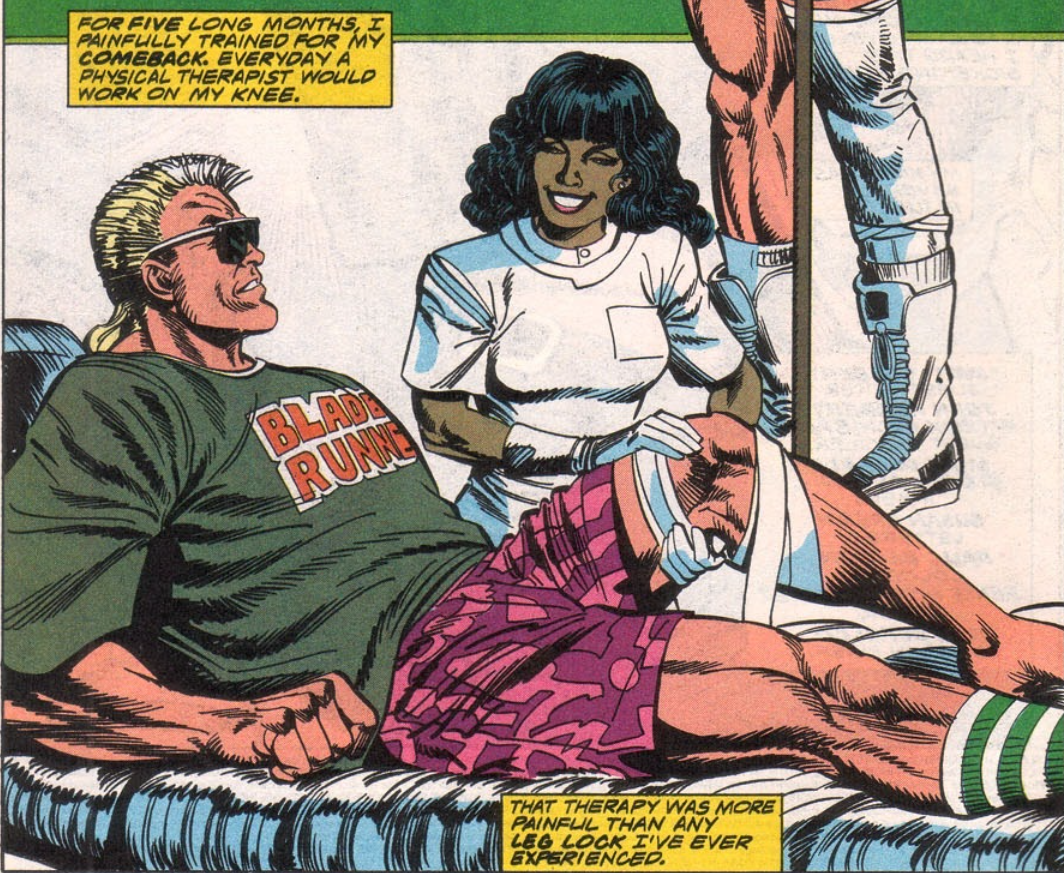


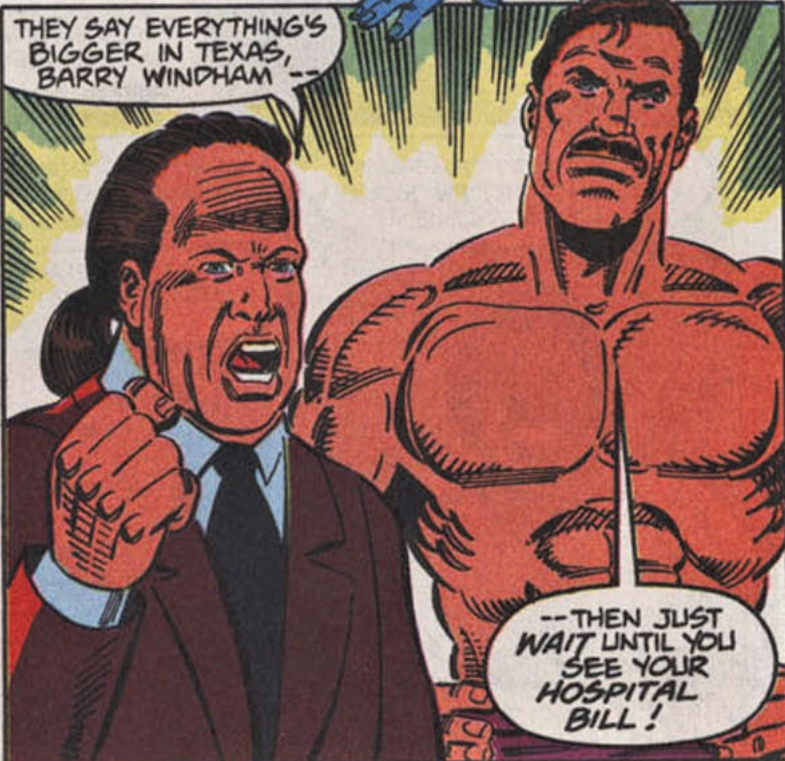

Conclusion
Around 1995 with Eric Bischoff at the helm, WCW enjoyed a period of mainstream success characterized by a shift to reality-based storylines and often anchored with former WWF talent. And from 1996 to 1998, the promotion peaked when winning the Monday Night Wars in the ratings for 83 consecutive weeks.
There was a small window where WCW was not only winning the intense weekly battle but was also poised to claim victory over the whole wrestling war.
Ultimately, it didn’t happen, and they got bought out in March of 2001.
The World Championship Wrestling comic is another reminder of WCW’s various missed opportunities. And while Spider-Man, Hulk, and Thor didn’t lose much sleep over the WCW boys closing shop, their misadventures in the comic industry still had some fun moments.
These stories may also interest you:
Want More? Choose another story!
Be sure to follow us on Facebook, Twitter, and Instagram!
Got a correction, tip, or story idea? Reach out to our team!
This post may contain affiliate links, which means we may earn a commission at no extra cost to you. This helps us provide free content for you to enjoy!
This post was originally published on this site be sure to check out more of their content.








